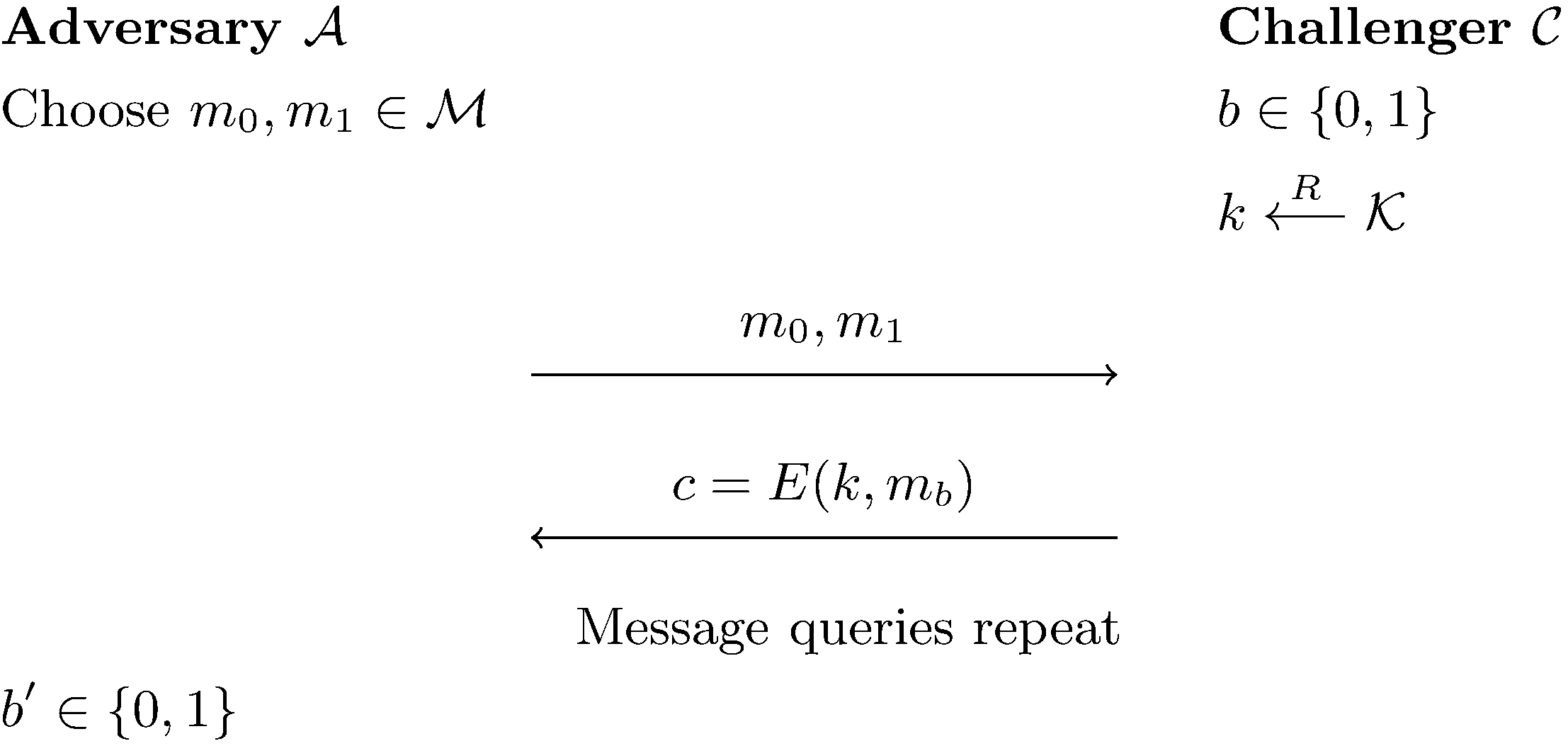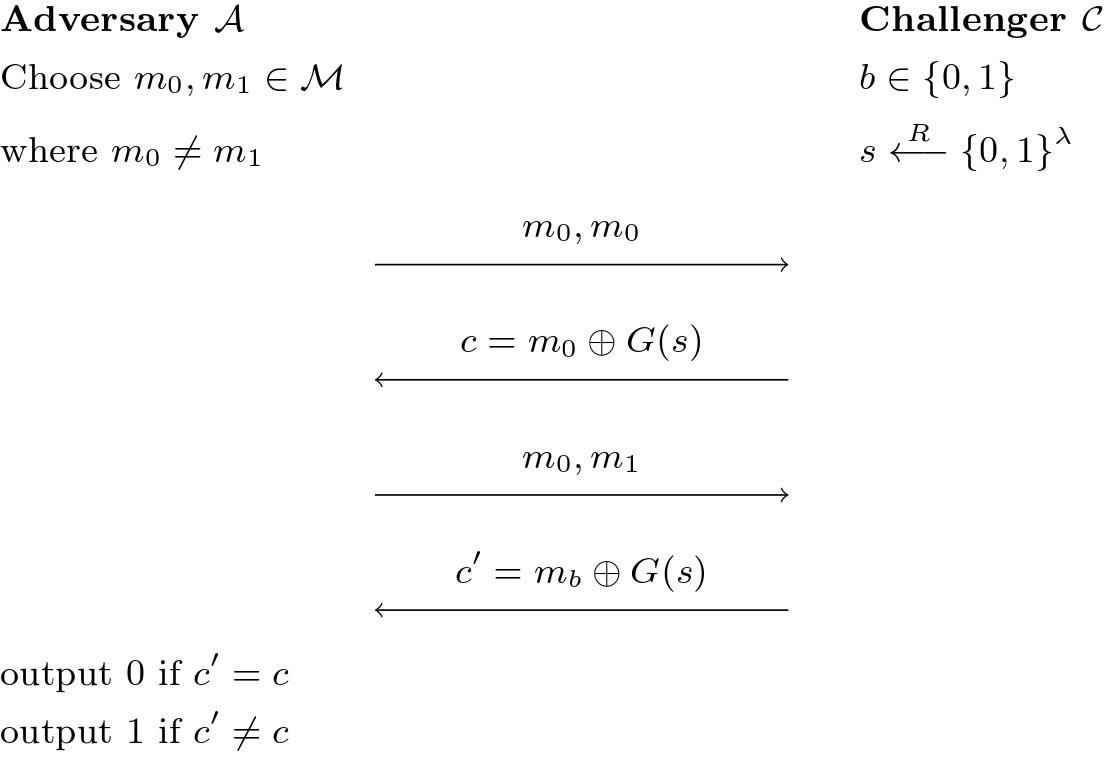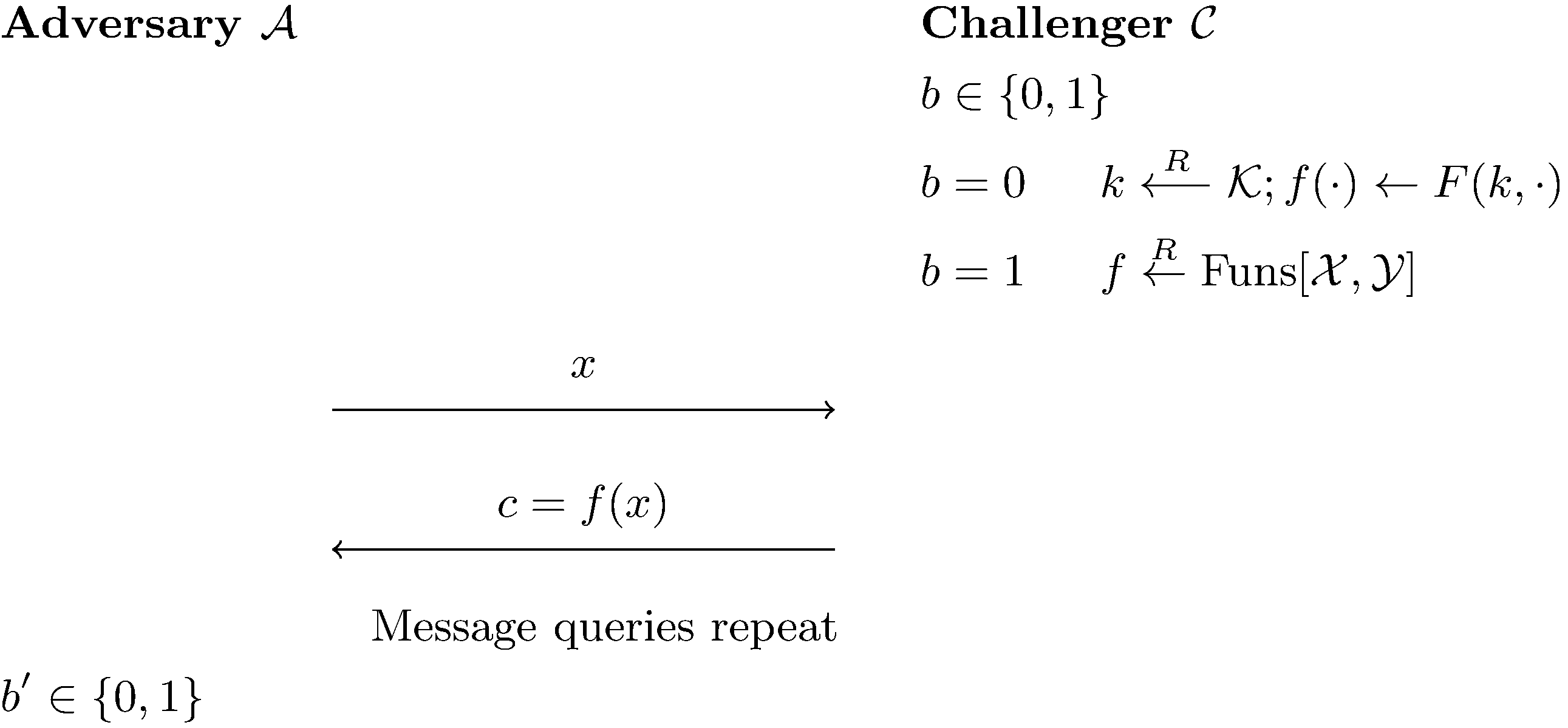Graduate Cryptography Note 2
All info comes from David Wu’s Lecture and Boneh-Shoup Book.
This note will be focusing on PRG security, PRF and Block Cipher.
Claim: If PRGs with non-trivial stretch ($n > \lambda$) exists, then $P\neq NP$.
Suppose $G :\lbrace 0,1\rbrace^\lambda \to \lbrace 0,1\rbrace^n$ is a secure PRG, consider the decision problem: on input $t\in \lbrace 0, 1\rbrace ^n$, does there exist $s \in \lbrace 0,1\rbrace^\lambda$ such that $ t = G(s)$.
The reverse search of $G$ is in $NP$. If $G$ is secure, then no poly-time algorithm can solve this problem.
If there is a poly-time algorithm for the problem, it breaks PRG in advantage of $1 - \dfrac{1}{2^{n-\lambda}} > \dfrac{1}{2}$ since $n>\lambda$.
CPA (Chosen Plaintext Attack) Security
Semantic Security still holds even if multiple ciphertext is seen by adversary.
The adversary can send multiple round of message query $m_0,m_1 \in \mathcal{M}$ to challenger and the challenger will send back one ciphertext $c_b$ with $k \overset{R}{\longleftarrow}\mathcal{K}$ and $b \in \lbrace 0, 1\rbrace$. The semantic security still holds.
CPA-Secure is defined by: An encryption scheme $\Pi_{SE} = (\text{Encryption},\text{Decryption})$ is CPA-Secure if $\forall \mathcal{A}$ efficient adversaries: $\text{CPAAdv}\lbrack \mathcal{A},\Pi_{SE}\rbrack = |\Pr\lbrack W_0 = 1\rbrack - \Pr\lbrack W_1 = 1\rbrack | = \text{negl}$.
$W_b$ means the experiment encrypt $m_b$ and $\mathcal{A}$’s guessing result.

A stream cipher is not CPA-secure.

The adversary is efficient:
- The query number is 2, a constant.
- $\Pr\lbrack \text{output}=1 \vert b=0\rbrack = 0$ and $\Pr\lbrack \text{output} = 1\vert b=1\rbrack = 1$, thus $\text{CPAAdv}\lbrack\mathcal{A},\Pi_{SE}\rbrack = 1 \gg\text{negl}$.
One thing we notice is that CPA-secure encryption is randomized rather than deterministic. Encrypting the same message twice should not reveal that identical messages were encrypted.
PRF and PRP (Block Cipher)
Key crypto building block is called PRF (pseudo random function). A similar notion is PRP (pseudo random permutation), or block cipher.
Block cipher is an invertible keyed function: takes in a block of $n$ bits and outputs $n$ bits.
But it is not a encryption scheme, and it would end up with very broken stuff. It is a building block for secure encryption (maybe CPA secure or even more secure)
We define PRF by $F:\mathcal{K}\times\mathcal{X}\to\mathcal{Y}$ with key space $\mathcal{K}$ and domain $\mathcal{X}$ and range $\mathcal{Y}$ if $\forall \mathcal{A}$ efficient can have only $|W_0 - W_1| = \text{negl}$, where $W_b$ is the probability $\mathcal{A}$ outputs 1 in the experiment

We define $\text{PRFAdv}\lbrack\mathcal{A}, \text{F}\rbrack = |W_0 - W_1|$.
The size of $\text{Funs}\lbrack\mathcal{X,Y}\rbrack = |\mathcal{Y}|^{|\mathcal{X}|}$.
PRP is a $F:\mathcal{K}\times\mathcal{X}\to\mathcal{X}$ if
- $\forall k \in \mathcal{K}$, $F(k,\cdot)$ is a permutation on $\mathcal{X}$.
- $F^{-1}(k,\cdot)$ is efficient to compute $\forall x\in\mathcal{X},\forall k\in\mathcal{K}, F^{-1} (k,F(k,x))=x$.
- $k\overset{R}{\leftarrow} \mathcal{K}: F(k,\cdot)$ is computationally indistinguishable from $f(\cdot) \overset{R}{\leftarrow}\text{Perm}\lbrack \mathcal{X}\rbrack$. ($\text{Perm}\lbrack \mathcal{X}\rbrack$ is the set of all permutations on $\mathcal{X}$)
In this way, block cipher is another term of PRP.
PRF implies PRG
Noticing that a block cipher has form $F:\lbrace 0,1\rbrace^\lambda \times \lbrace 0,1\rbrace ^n\to\lbrace 0,1\rbrace ^n$, we can define a PRG with $G:\lbrace 0,1\rbrace^\lambda \to \lbrace 0,1\rbrace^{ln}$, $G(k) = F(k,1)\parallel F(k,2) \parallel \cdots \parallel F(k,l)$.
Theorem: If $F$ is a secure PRF, then $G$ is a secure PRG.
We can construct the following experiment, say if $G$ is not secure, we can use it to break $F$.

We can see that $\text{PRFAdv}\lbrack \mathcal{B},F\rbrack = |W_0 - W_1| = \text{PRGAdv}\lbrack \mathcal{A}, G\rbrack$.
$\mathcal{B}$ query is efficient by $\mathcal{A}$ efficient and $l$ polynomial. ($l < 2^n$ or $n > \log l$)
PRF and PRP Distinctions
One thing we must see that the definition of PRF and PRP differ a little. For PRF, $f(1)=f(2)$ with probability $\dfrac{1}{2^n}$ but in PRP $f(1) = f(2)$ has no probability.
The adversary will not know until he sees a collision, or $f(x) = f(y)$.
PRF Switching Lemma: Let $F :\mathcal{K\times X \to X}$ be a secure PRP. For any $Q$ query adversary $\mathcal{A}$, $|\text{PRPAdv}\lbrack \mathcal{B},F\rbrack - \text{PRFAdv}\lbrack \mathcal{A}, G\rbrack| \leq \dfrac{Q^2}{2|\mathcal{X}|}$.
Since $\Pr\lbrack x ,y \overset{R}{\leftarrow}:x=y\rbrack = \dfrac{1}{|\mathcal{X}|}$. Also by $Q$ query takes $Q$ random points and compose $\dfrac{Q^2}{2}$ pairs, the total collision probability is $\dfrac{Q^2}{2|\mathcal{X}|}$.
For adversary, he should go $Q \sim \sqrt{|\mathcal{X}|}$, if $Q \ll \sqrt{|\mathcal{X}|}$ then it is safe to use PRF.
PRF/PRP Reusable Encryption Scheme
In this way, PRP/PRF in “counter mode” gives us a stream cipher, but this is just one-time encryption scheme.
Randomized Counter Mode
$$
\newcommand{\da}[1]{\bigg\downarrow\raise.5ex\rlap{\scriptstyle#1}}
\begin{array}{ccccccccc}
IV &&&& IV &&&& IV+1 &&&& \dots &&&& IV+l-1\newline
&&&& \da{E_k} &&&& \da{E_k} &&&& &&&& \da{E_k}\newline
&&m_1\longrightarrow&&\oplus&&m_2\longrightarrow&&\oplus&&&&&&m_{l-1}\longrightarrow&&\oplus\newline
&&&&\da{}&&&&\da{}&&&&&&&&\da{}\newline
IV &&&&c_1&&&&c_2&&&&\dots&&&&c_{l-1}
\end{array}
$$
We can choose a random starting point called initializing vector, and this is called randomized counter mode.
Theorem: Let $F : \mathcal{K\times X \to Y}$ be a secure PRF and $\Pi_{CTR}$ be randomized counter mode encryption scheme from $l$-block messages ($\mathcal{M=Y^{\leq l}}$).
Then $\forall\mathcal{A}$ efficient CPA adversaries, $\exists\mathcal{B}$ efficient PRF adversary
$$
\text{CPAAdv}\lbrack\mathcal{A},\Pi_{CTR}\rbrack \leq \dfrac{4Q^2l}{|\mathcal{X}|} + 2\cdot \text{PRFAdv}\lbrack\mathcal{B},F\rbrack
$$
The proof intuition can be considered:
If there are no collision, or PRF never evaluate on a same block, then it is as if everything is encrypted under OTP.
Collision event: $(x, x+1,\dots, x+l-1)$ overlaps with $(x’,x’+1,\dots,x’+l-1)$ when $x,x’\overset{R}{\longleftarrow}\mathcal{X}$, then the probability of collision is $\dfrac{2l}{|\mathcal{X}|}$.
The total possible pairs among $Q$ queries will be $\leq Q^2$, thus $\Pr\lbrack\text{collision}\rbrack \leq \dfrac{2lQ^2}{|\mathcal{X}|}$.
Design 4 experiments with intermediate distributions:
- $W_0$: Encrypt $m_0$ with PRF
- $W_1$: Encrypt $m_0$ with OTP
- $W_2$: Encrypt $m_1$ with OTP
- $W_3$: Encrypt $m_1$ with PRF
Here we can see $|W_0 - W_1| = |W_2 - W_3| = \dfrac{2Q^2l}{|\mathcal{X}|} + \text{PRFAdv}\lbrack\mathcal{B},F\rbrack$, thus $|W_0 - W_3|$, which is CPA advantage, must satisfy $\text{CPAAdv}\lbrack\mathcal{A},\Pi_{CTR}\rbrack \leq \dfrac{4Q^2l}{|\mathcal{X}|} + 2\cdot \text{PRFAdv}\lbrack\mathcal{B},F\rbrack$.
Nonce-Based Counter Mode
Divide $IV$ into two pieces: $IV = \text{nonce} \parallel \text{counter}$.
The only requirement here is that the nonce does not repeat in the encryption process.
Counter mode can be parallelized.
Cipherblock Chaining (CBC Mode)
Cipherblock is chained up in the encryption session
$$
\newcommand{\ra}[1]{!!!!!!!!!!!!\xrightarrow{\quad#1\quad}!!!!!!!!}
\newcommand{\da}[1]{\bigg\downarrow\raise.5ex\rlap{\scriptstyle#1}}
\begin{array}{ccccccccc}
&&&&b_0&&&&b_1&&&&b_2&&&&\dots&&&&b_n\newline
&&&&\Big\downarrow&&&&\Big\downarrow&&&&\Big\downarrow&&&&&&&&\Big\downarrow\newline
IV&&\to&&\oplus&&&&\oplus&&&&\oplus&&&&&&&&\oplus\newline
&&&&\da{E_k}&&\nearrow&&\da{E_k}&&\nearrow&&\da{E_k}&&\nearrow&&&&\nearrow&&\da{E_k}\newline
&&&&c_0&&&&c_1&&&&c_2&&&&&&&&c_n
\end{array}
$$
and the structure of decryption of
$$
\newcommand{\ra}[1]{!!!!!!!!!!!!\xrightarrow{\quad#1\quad}!!!!!!!!}
\newcommand{\da}[1]{\bigg\downarrow\raise.5ex\rlap{\scriptstyle#1}}
\begin{array}{ccccccccc}
&&&&c_0&&&&c_1&&&&c_2&&&&\dots&&&&c_n\newline
&&&&\da{E_k^{-1}}&&\searrow&&\da{E_k^{-1}}&&\searrow&&\da{E_k^{-1}}&&\searrow&&&&\searrow&&\da{E_k^{-1}}\newline
IV&&\to&&\oplus&&&&\oplus&&&&\oplus&&&&&&&&\oplus\newline
&&&&\da{}&&&&\da{}&&&&\da{}&&&&&&&&\da{}\newline
&&&&b_0&&&&b_1&&&&b_2&&&&&&&&b_n
\end{array}
$$
Theorem: Let $\mathcal{K\times X\to Y}$ be a secure PRF and $\Pi_{CBC}$ be CBC encryption scheme for $l$-block message ($\mathcal{M = Y^{\leq l}}$).
Then $\forall\mathcal{A}$ efficient CPA adversaries, $\exists\mathcal{B}$ efficient PRF adversary
$$
\text{CPAAdv}\lbrack\mathcal{A},\Pi_{CTR}\rbrack \leq \dfrac{2Q^2l^2}{|\mathcal{X}|} + 2\cdot \text{PRFAdv}\lbrack\mathcal{B},F\rbrack
$$
The only difference here is that the collision between $Q$ intervals of $l$ length is changed to $Ql$ random blocks.